| | Water wells | Dugouts | Natural water sources | Pipelines | Legislation | For more information
Water supply is critical to any farm or farmstead. Both the quantity and quality of water are important, and every effort must be made to conserve supplies and prevent contamination.
Major water sources for farmsteads include water wells, dugouts, natural water sources and pipelines. Contamination of any water supply can occur in a variety of ways. However, with proper planning and management, any environmental or health safety risks can be eliminated or minimized.
Water Wells
One of the most important assets on your farmstead is the water well. Albertans typically choose water wells wherever there is an adequate supply of good quality groundwater.
When analyzing the quality and quantity of water from the well, gather as much information about all wells, used and unused, on the farmstead that you can, including the following:
- number of wells located on the farmstead
- well type
- purpose
- construction date(s)
- depth
- casing size
- well yield in gallons per minute
- supply or quality problems
- location of the well in proximity to potential environmental hazards
If you do not have copies of the original water well driller’s reports, you can obtain them from the Groundwater Information Center. (For contact information, refer to For More Information at the end of this chapter.)
Water volume
Aquifers are recharged by precipitation or infiltration from surface water bodies normally in the spring and early summer when precipitation exceeds evaporation and transpiration rates of plants. Shallow water table levels will naturally fluctuate seasonally (increasing in the spring and decreasing over the rest of the year) as the water is used by plants, discharged to springs or recharging deeper aquifers. Water levels in deeper aquifers will fluctuate less and only show changes after long periods of drought or water use. Water pumped out of wells will reduce the levels further. It is extremely important that the volume of water being pumped from the well does not exceed the recharge capacity of the aquifer supplying the well. This situation can potentially make the groundwater unavailable over time.
If groundwater withdrawal from an aquifer is faster than its recharge rate, then the groundwater is “mined” from the aquifer. Groundwater mining is often an unintentional process. As the old adage says “you don’t miss the water until the well goes dry.”
For most household situations, wells with a production rate of less than five gallons per minute (gpm) for a one-hour period (during peak use) do not supply enough water. It becomes necessary to create additional water storage using a tank or cistern. If the short term water requirements exceed the well pumping rate, it is often beneficial to use a cistern to accumulate water. This stored water can then be re-pumped into the distribution system to meet short term demands.
For example, a well capable of pumping only 1 gpm could only supply enough water for a few cows if it was pumped directly into a stock waterer. However, if that same well pumped into a cistern for storage for 15 hours per day and then pumped to a stock tank at 10 gpm, it could supply 60 cows.
Cisterns
Adding a cistern to a farmstead can help supplement slow-producing wells that do not produce sufficient water to meet peak water demands. A cistern that will hold one half to one day’s water storage can eliminate the need for another well or wells. The water can then be re-pumped at a much faster rate to meet the peak demands.
Well location
To avoid water quality problems, a well should be located on high ground that is not subject to flooding and upslope from any potential or known contaminant sources such as livestock corrals, manure storage, household sewage systems, etc. (see Figure 3.1). Setback distances, also known as minimum distance separations (MDS), are required legally or recommended for locating your well.

Figure 3.1. Possible hazards to water well
Minimum distance requirements in Alberta indicate the well must be at least:
- at a site where the well is accessible for servicing
- 3.25 m (11 ft) from a building
- 10 m (33 ft) from a watertight septic tank
- 15 m (49 ft) from a sub-surface weeping tile effluent disposal field or treatment mound
- 50 m (164 ft) from sewage effluent discharge to the ground
- 100 m (328 ft) from a sewage lagoon
- 50 m (164 ft) from above-ground fuel storage tanks
- 100 m (328 ft) from a manure storage facility or collection area or livestock yard
- 30 m (98 ft) from a manure application area
- 500 m (1,640 ft) from a sanitary landfill, modified sanitary landfill or dry waste site
- 100 m (328 ft) from any dead animal burial or composting site
- 30 m (98 ft) from any old existing leaching cesspool; the installation of a leaching cesspool is no longer permitted
(Note: equivalent imperial distances in feet are rounded up to nearest foot.)
Well construction
A water system that is well planned and properly constructed will ensure that you and your family have a reliable and safe water supply. A poorly constructed or located well provides a direct path for contaminants to travel from the surface directly to the aquifer.
Multi-aquifer well completion allows water to mix from several aquifers, which may have significantly different water qualities (see Figure 3.2). Multi-aquifer completion can also allow water to drain from one aquifer into another, depleting some aquifers and potentially contaminating others. The driller must ensure that the water well is constructed in a manner that does not result in multi-aquifer completion.
Installing a proper well casing and formation seal effectively prevents contaminated surface water, or groundwater, from seeping along the outside of the casing and entering your well (see Figure 3.3).
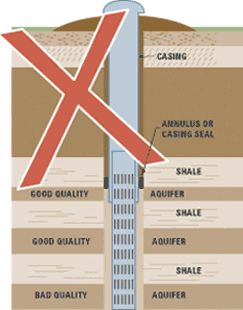 |  | 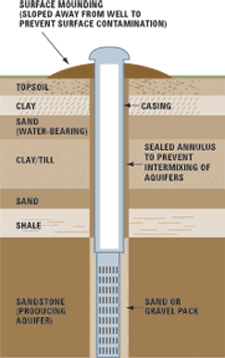 |
| . |  |  |
| Figure 3.2. Multi-Aquifer well completion |  | Figure 3.3. Annulus or casing seal |
Testing for water quality
All farm water sources should be tested when the supply is connected initially and again about every 1 to 2 years. Test the water more often if you notice a significant change in the water quality, if a toxic spill occurs nearby or if a change occurs in land use or activity. A thorough chemical and microbiological analysis of water for household use can be done through your local health region. Water samples for agricultural purposes can be taken to private labs for testing. These labs will supply sample bottles and the correct procedures for sampling.
Well pits
Provincial regulation now prohibits locating wells in pits. Well pits provide a place for contaminated surface water or shallow groundwater to collect, which can contaminate the aquifer by seeping around the outside of the well casing or flowing directly into the well. This type of construction also makes the well very susceptible to contamination by small animals and insects.
Well pits can be a deadly safety hazard and should not be used for storage areas. With changes in atmospheric pressure, air from within the well casing can displace breathable air in the well pit. Methane gas may also build up in the pit creating potentially dangerous situations such as explosions. Well gases or low oxygen content in well pits have resulted in human deaths as people entering these well pits become asphyxiated. It is strongly recommended that well pits be removed by an experienced backhoe or well drilling contractor and pitless adaptors be installed.
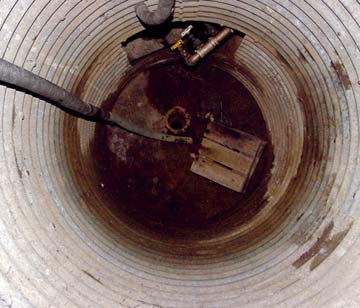
Well pits are no longer used in new well construction
Courtesy of PFRA
Farm water hydrants installed in a well or well pit
Hydrants are designed to prevent freezing by draining water from the hydrant standpipe whenever the hydrant is shut off. If a hydrant is installed in a well casing or well pit, the contents of the standpipe will siphon back into the well. If a hose is directly connected to the hydrant and the other end of the hose is in a stock tank or pesticide sprayer tank, the contents of the tank will be siphoned down the well. The contents of stock tanks or sprayers are definite contaminants. Always maintain an air gap between the end of a hose and the water surface, and disconnect hoses from the hydrants when not in use. Using a hose connection vacuum breaker on every hydrant can also provide additional protection.
Flowing wells
The water from flowing wells must be controlled to prevent depletion of the water resource. Free-flowing water wells in some areas of the province have drastically lowered water levels in neighbouring wells, wasted the resource and contributed to saline soil conditions in the overflow area.
Under the Water Act, flowing wells must be controlled. Ideally the flow should be shut off when the water is not in use. The regulations require that the flow rate does not exceed either the water requirements of the well owner, or 100 cubic metres per week (2.18 gal/min), whichever is smaller. If the flow requirement exceeds 100 cubic metres per week, the water use must be licensed.
Restricting the flow can be accomplished by a variety of methods. Talk to a well driller or plumber about the most practical method for your situation.
Old and abandoned wells
A great number of rural residents rely on water wells. While the exact number of abandoned wells in Alberta is unknown, it is estimated to be in the tens of thousands. Abandoned wells that are no longer used or maintained for future use pose a serious threat to the preservation of groundwater quality. They are also a serious safety and environmental hazard for children and animals.
Old wells may be poorly constructed or have a rusted steel casing that can lead to the contamination of aquifers and neighbouring wells. When the steel casing of an abandoned well starts to corrode, holes will develop. When this situation occurs, surface contaminants or poor quality water from shallow aquifers may migrate into the deeper aquifers of nearby operating wells.
Unfortunately, groundwater contamination and its effects are usually not recognized until groundwater quality is seriously affected and nearby wells have been contaminated. Surface contaminants can enter a well directly through the top of the casing, if there is not a proper well cap, or through unsealed spaces along the outside of the casing.
Old and abandoned wells should be decommissioned or plugged to prevent the following problems:
- downward movement of water in the well or well annulus
- surface contamination from reaching aquifers
- intermixing of water between aquifers of different water quality
Who is responsible?
In Alberta, responsibility for plugging a water well is defined by legislation. The drilling contractor is legally responsible for immediately plugging a well that is not completed due to construction problems or inadequate yield. The well owner is responsible for plugging the well when:
- the well is no longer being used as a water supply
- the well is in a poor state of repair and the pumping equipment has been removed or cannot be repaired or replaced
- the well produces water that is unsuitable for drinking
Unless you use the right plugging materials and have them properly placed in the well, you will end up with a poorly sealed well that can allow contaminants to enter the groundwater. It is generally best to hire a drilling contractor to complete the plugging of your well. This person has the expertise and equipment to do a proper job.
Dugouts
Dugouts are often used on farmsteads as a water source. If the site has a low, poor quality groundwater supply, dugouts may be used exclusively, or in combination with a well. If a farmstead has both, the well water is usually saved for household use because it is typically of better quality.
Dugouts are usually filled by surface water and can provide good quality water for livestock and irrigation purposes. However, there is a greater risk of contaminants entering the dugout as many are typically filled by spring runoff or water from irrigation canals, creeks, rivers or lakes. Some dugouts are groundwater-filled and may pose a higher risk of groundwater contamination and should be managed accordingly. It is important to always monitor a dugout’s water quality.
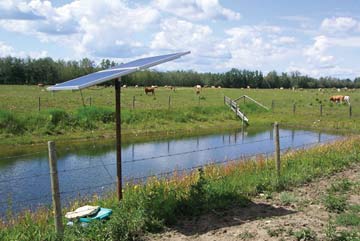
Dugout fenced to protect water quality
Courtesy of ARD
Generally, dugouts have high levels of organic matter, but surface runoff high in particulate matter and plant nutrients increase these levels. This situation results in significant algae and weed growth, eventually resulting in poor water quality. Thus, it is important that dugouts be monitored, maintained and treated to avoid water quality issues.
Traditionally, dugout water was not treated or treatment consisted of a combination of chlorination, rapid sand filtration and/or granular activated carbon filtration. However, better water treatment systems exist today and include conventional treatment systems involving chemical coagulation. Coagulation is the process of adding chemicals to the dugout water to reduce turbidity, dissolved organic compounds and colour. The chemicals cause small particles to bind together forming larger particles that can be removed from the water either through sedimentation or direct filtration. This treatment can occur in dugouts or coagulation cells that treat a six to twelve-month supply of household water.
Dugouts that are only filled by spring runoff should be designed to hold at least a two-year water supply plus any additional evaporation and seepage losses, unless an alternative water source can be used to fill the dugout in a drought year. Dugouts in irrigated areas or adjacent to rivers or lakes must be at least large enough to supply water from the time the water is not available in the fall until water flows again in the spring.
The size of a dugout required for a livestock operation varies with the water requirements of the operation, the refill frequency of the dugout and assessments of seepage and ice thickness. Seepage losses from dugouts do occur and are variable. Dugout evaporation ranges from 15 percent in northern Alberta to 30 to 50 percent in southern Alberta, while dugouts used for winter water supplies will lose approximately 25 percent to ice. A deeper dugout with steep slopes will provide the best water quality and help minimize such losses.
Knowing your daily water requirements helps you determine the best dugout size for your farmstead. Other things to know:
- dugout purpose
- age
- size
- approximate water volume
- potential problems with seepage, quality or inadequate runoff
Some dugouts may require licensing by Alberta Environment. Check with Alberta Environment to ensure all legislative requirements are met when planning any of the following situations where dugouts are:
- constructed in waterways
- intercepting groundwater
- over 12,500 cubic metres (2,749,615 gallons) in size
- using more than 6,250 cubic metres (1,374,807 gallons) of water a year
Contact your local Agriculture and Agri-Food Canada - Prairie Farm Rehabilitation Administration (AAFC-PFRA) and Alberta Agriculture Food and Rural Development (ARD) water specialists for proper dugout planning and design information.
Management of inflow water into dugouts
If you are planning to fill the dugout from runoff or an irrigation canal, be sure to:
- locate the dugout upstream of any livestock area
- construct a berm around the dugout (if filled from irrigation water) to prevent potential runoff from entering water supply
- fence the dugout to prevent animals from entering the water supply
- install a pumping system with a floating intake
- aerate to prevent the water from becoming stagnant
A dugout in the middle of a waterway becomes a sediment trap and silts in more quickly. Wherever possible, dugouts should be located beside the water runway and have a short water diversion channel connecting the two. This set-up allows you to control the water that flows into the dugout, while unwanted or contaminated water can be redirected to bypass the dugout. For more information on planning, designing and operating dugouts, refer to ARD publications listed at the end of this chapter.
Natural Water Sources
Natural water sources exist on many farmsteads and include undeveloped springs, lakes, wetlands, creeks and sloughs. These may be locations where water flows year round, intermittently or seasonally. Managing for healthy water sources ensures a sustainable water supply for the future.
The concern when dealing with natural water sources is the distance of potential hazards, such as pesticides, fertilizers or manure to the water source. For example, when animals have direct or limited access to a spring or creek, the risk for contamination increases. Animals may affect the quantity or outflow of the water source. Creating pasture riparian areas and other buffer zones allows you to manage and maintain water quality. Offsite livestock watering systems, such as solar and nose pumps, will also protect water sources from potential contamination.
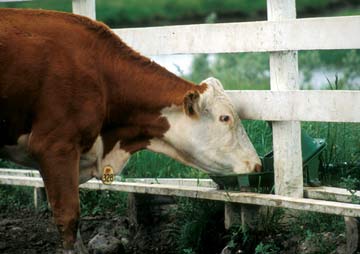
Alternative livestock watering systems such as nose pumps help protect water sources from contamination risks
Courtesy of ARD
Pipelines
Some rural residents are supplied with water from community pipelines, which either deliver treated potable water or untreated raw water.
If the pipeline supplies treated water, the major concern is maintaining the water quality once it is at the farmstead. Most pipelines deliver a low volume of water (often 1-2 gallons per minute) to a cistern at the farm site. It is important that the cistern be secure with a cover to prevent access by rodents, insects, children, etc. or contaminants from entering the water supply.
Clean and disinfect your cistern at least once a year:
- Drain and clean the tank.
- Inspect for cracks or leaks as water can leak both in or out.
- Fill the tank with potable water.
- Disinfect with 100 mg/l chlorine solution with 8 litres of household bleach per 4500 litres (1000 gal) of water.
- Run water out of each water line to get the bleach into the entire piping system.
- Let sit for at least 20 minutes.
- Drain the chlorinated water from the tank.
- Refill with potable water.
If your pipeline supplies untreated water to the farmstead, make sure the water is treated appropriately, so the water becomes suitable for home use. Many treatment systems are available for a variety of water problems. Check with a AAFC-PFRA or ARD water specialist or health inspector to determine what options may be best for you.
Any community pipeline system should be protected from backflow and cross connections that may originate at a farm. This precaution usually involves backflow prevention devices that are specified by the utility that supplies the water. These are designed to keep contaminated water from being pumped or “sucked” into the pipeline.
Shallow buried pipelines that are not designed for year round use are more susceptible to contamination and breaks. Proper backflow prevention is strongly recommended for farms that use these shallow buried pipelines to supply water to livestock pastures. Prevention may be as simple as maintaining an air gap at the float valve or installing a special backflow preventer.
As mentioned previously, it is very important to test all farm water sources on a regular basis, including water supplied from community pipelines as potential contamination of the water source may occur at different points along the pipeline.
Legislation
Producers should be aware of the following pieces of legislation that pertain to water sources and the potential environmental risks. For more information on the legislation, refer to Chapter 12 of this manual.
Federal Legislation
Fisheries Act
Provincial Legislation
Water Act
Environmental Protection and Enhancement Act
For More Information
All Alberta government offices may be reached toll-free by dialing the Rite Line: 310-0000
Alberta Agriculture and Rural Development
Publications: 1-800-292-5697
Ag-Info Centre: 310-FARM (3276)Website: www.agric.gov.ab.ca
Alberta Environment
Publications: 780-427-2700
- Prevention of Water Contamination by Pesticides
- Water Act: Fact Sheets
Groundwater Information Centre: 780-427-2770Website: www.gov.ab.ca/env
Agriculture and Agri-Food Canada
Publications: 613-759-6610
- The Health of Our Water No. 2020E
- Water Wells – Maintaining a Valuable Prairie Resource
Website: www.agr.gc.ca/pfra
Agriculture and Agri-Food Canada – Prairie Farm Rehabilitation Administration
Publications: contact your regional office
- Dugouts for Farm Water Supplies
- Rural Water Quality and You Information Sheets
- Shelterbelts for Dugouts
- Water Quality Matters Fact Sheets
- Wells for Farm Water Supplies
Website: www.agr.gc.ca/pfra
Department of Fisheries and Oceans
Publications: contact your regional office
- Alberta Operational Statement
- Culvert Maintenance
- Isolated Ponds
- The Fish Habitat Primer – Prairies Edition
Website: www.dfo-mpo.gc.ca
Health Canada
Publications: 1-800-635-7943
- Guidelines for Canadian Drinking Water Quality
Website: www.hc-sc.gc.ca
The Groundwater Centre
Office: 1-800-GEO-WELL (436-9355)
Website: www.groundwatercentre.com |
|